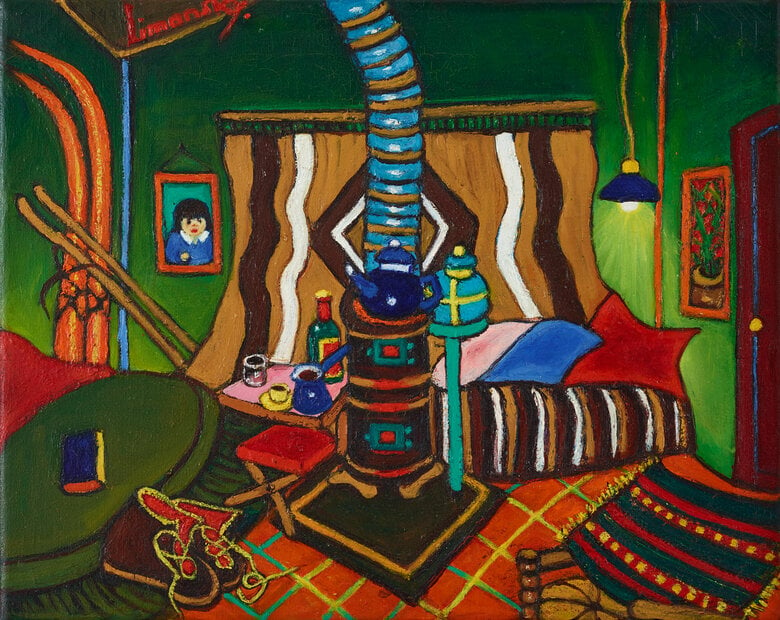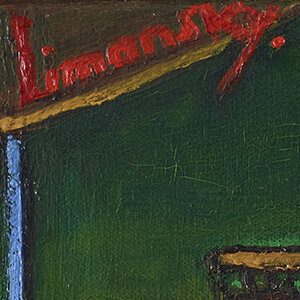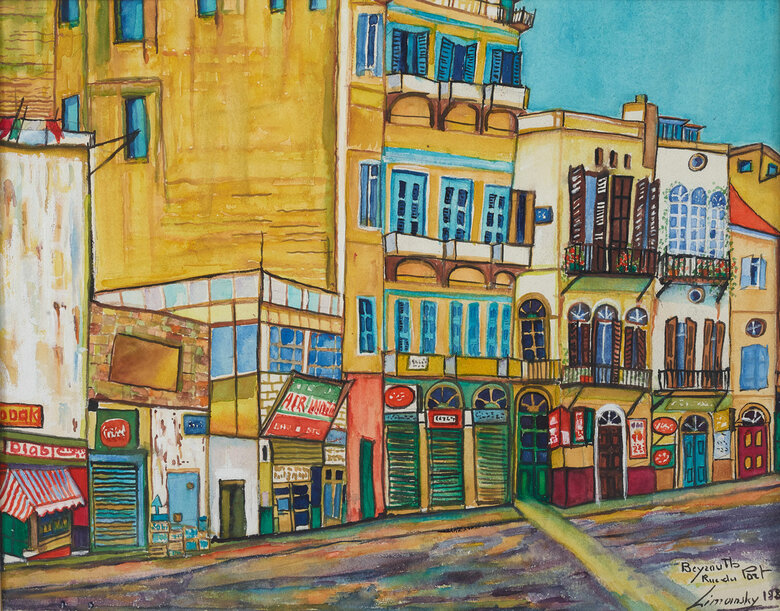Born in Russia in 1903, Olga Limansky was a self-taught painter who embarked on an artistic journey that began later in life but left an enduring mark on the world of art. Her passion...





Born in Russia in 1903, Olga Limansky was a self-taught painter who embarked on an artistic journey that began later in life but left an enduring mark on the world of art. Her passion...
Born in Russia in 1903, Olga Limansky was a self-taught painter who embarked on an artistic journey that began later in life but left an enduring mark on the world of art. Her passion for visual arts only blossomed at the age of fifty-five. 1 Yet, her paintings would portray Lebanon's urban and rural landscapes, capturing its vibrant beauty with a vivid and expressive palette. In 1917, when Olga was twelve, she and her parents migrated from Russia to Ukraine. Their journey eventually led them to Damascus, Syria, and then to Beirut, Lebanon, where they settled in 1922. There, she established a life for herself, and in 1927, she married a Cossack officer and French pilot, embarking on a new chapter in her life. Olga spent much of her life working at the French Embassy in Beirut, showcasing her dedication and commitment to her career. However, it was not until a pivotal moment that the artist within her emerged; it was when her friend, Hungarian painter Jean Benedek,. 2 , gifted her a box of watercolors. Jean Benedek was the founder of Café la Palette, a meeting place for artists of diverse backgrounds to discuss the ideas of their time. 3
Drawn by the beauty of Lebanon's landscapes and daily life, Olga's creativity soared as she painted children's portraits, still life compositions including vases of flowers, and traditional Lebanese houses in Byblos and Broumana. She most notably captured the lively urban life of Beirut's golden era (1955-1975). Beirut, Rue du Port, N.D, a watercolor painting part of the Dalloul Art Foundation collection, vividly portrays the residential and commercial vibrancy of Beirut's Port area. This remarkable painting showcases Beirut's old architectural style, featuring adjacent low-rise narrow buildings with bustling retail shops on the ground floors. Beirut, Rue du Port, N.D verifies Limansky's attention to detail; the artist had intricately painted the shop signs, slender balconies, arcaded windows, and colorful wooden louvered shutters, all bringing the scene to life.
Limansky's approach to art was distinct from so-called naive painters. Her lack of formal technical training granted her a unique immediacy and intensity in her vision, allowing her paintings to exude life and recount a thousand memories. This captivating effect is aptly named the "Limansky effect" 4, and enabled her to infuse objects with personal touches, humanizing them and embracing the world's diversity of experiences. Olga Limansky's artistic journey was anything but conventional. Having had no formal education in the arts, she relied on her innate perceptive innocence as a gift to navigate the canvas with authenticity and emotion. Her life had seen two exoduses and two exiles, witnessing the tumultuous 1917 October Revolution 5 , which is also known as the Bolshevik Revolution 6 , in her country of origin. However, at the age of sixty-five, after retiring and amidst the backdrop of the Lebanese Civil War, Olga embarked on her pictorial career 7 .
In March 1976, at the height of the Lebanese civil war, tragedy struck when militiamen burned down her building in the Zeïtoune district in Beirut. 8 , leaving the residents with nothing but ashes of their possessions. The whole street was looted that same night, and Olga displayed notable resilience in the aftermath of the destruction. Still, she moved to Rabieh, in Mount Lebanon. Undeterred, she resumed painting from memory, capturing what had disappeared in her house in a hotel in Rabieh. Zeïtoune became the only major district in Beirut to be completely erased from history. While these recreated paintings had a lesser brilliance than the originals, they carried the essence of her spirit and determination. During this period of rekindling her artistic flame, Olga Limansky produced the captivating artwork Le Chalet de Ski, 1982, an oil on canvas painting and part of the Dalloul Art Foundation collection. This piece, tucked amidst her repertoire of evocative watercolors, reflects her ability to imbue her subjects with personal emotion and authenticity. Painted mainly with primary red, blue, and yellow tones, dominated by contrasting reds and greens, Chalet de Ski, 1982, depicts the cozy interior of a winter ski cottage. It portrays the typical cottage furniture: a fluffy sofa, wool carpets, warm beige and brown thick curtains, and a kerosene run heater in the center. Limansky even painted her ski boots, ski equipment, and a table with a cup of coffee. The painting resonates with the serene mountain landscape that emanates the tranquility Limansky sought amid the chaos of war and loss.
Olga Limansky's artistry transcended mere depiction; it preserved a slice of Lebanon's cultural heritage and the memories of a long-gone era. She exhibited her work in Rabieh, Broumana, and Beirut, including her latest show, Olga Limansky: Rabieh Club Exhibition in 1983 9. Her watercolors immortalized the sites, districts, streets, residences, and cafes that had long disappeared, providing a poignant window into Lebanon's rich history. In 1988, Olga Limansky passed away in Rabieh, Lebanon 10 , leaving behind a legacy that continues to captivate art enthusiasts and historians. Her vibrant and expressive paintings testify to her passion for colors and her deep connection with the land she embraced as her own. Until now, Olga Limansky's art remains part of Lebanon's artistic heritage. Her works serve as a timeless ode to a Beirut that once was, offering viewers a charming glimpse of the city's past and preserving its cultural treasures for generations to come.
Edited by WAFA ROZ
Notes:
1 “Olga Limansky - About.” n.d. www.olgalimansky.org. Accessed July 27, 2023.http://www.olgalimansky.org
2 Tarrab Joseph. "REGARD - Olga Limansky (1903-1988), hommage du centenaire: Le monde qui avait été le sien."
L'Orient-Le Jour. Accessed July 27, 2023.
3 For further on Café La Palette and John Benedek. Batycka, Dorian. 2019. “A TIMELINE to the GOLDEN AGE •
SELECTIONS ARTS MAGAZINE.” SELECTIONS ARTS MAGAZINE. January 2, 2019. https://selectionsarts.com
4 Tarrab Joseph."REGARD - Olga Limansky (1903-1988), hommage du centenaire: Le monde qui avait été le sien." L'Orient-Le Jour. Accessed July 27, 2023. https://www.lorientlejour.com
5 The Editors of Encyclopedia Britannica. 2019. “Russian Revolution | Definition, Causes, Summary, History, & Facts.” In Encyclopædia Britannica. https://www.britannica.com
6 Bolshevik (Russian: "One of the Majority"), plural Bolsheviks, or Bolsheviki, member of a wing of the Russian Social-Democratic Workers' Party, which, led by Vladimir Lenin, seized control of the government in Russia (October 1917) and became the dominant political power.
7 Kingston, Paul. 2018. “Lebanese Civil War | Lebanese History.” In Encyclopædia Britannica. https://www.britannica.com
8 Shehabeddine, Nabila. 2010. “LibGuides: Lebanese Civil War: 1975-1991: Home.” Libguides.com. 2010. https://aub.edu.lb.libguides
9 "Olga Limansky: Watercolors - Olga Limansky." n.d. Google Arts & Culture. Accessed July 27, 2023.https://artsandculture.google
10 “Olga Limansky | Biography.” n.d. Www.mutualart.com. Accessed August 3, 2023. https://www.mutualart.com
Sources
“Olga Limansky - Artist.” n.d. www.olgalimansky.org. Accessed July 27, 2023.
Tarrab Joseph."REGARD - Olga Limansky (1903-1988), hommage du centenaire: Le monde qui
avait été le sien." L'Orient-Le Jour. Accessed July 27, 2023. https://www.lorientlejour.com/
“OLGA LIMANSKY - Artists.” n.d. Dalloul Art Foundation. Accessed July 27, 2023.
https://dafbeirut.org/en/olga-...
"Olga Limansky: Watercolors - Olga Limansky." n.d. Google Arts & Culture. Accessed July 27,
2023. https://artsandculture.google
The Editors of Encyclopedia Britannica. 2019. “Russian Revolution | Definition, Causes,
Summary, History, & Facts.” In Encyclopædia Britannica. https://www.britannica.com
Kingston, Paul. 2018. “Lebanese Civil War | Lebanese History.” In Encyclopædia Britannica.
Selected Solo Exhibitions
Olga Limansky, Club de Rabieh, Rabieh, Lebanon
Olga Limansky: Aquarelles, Restaurant 73, Broummana, Lebanon
Olga Limansky: Aquarelles, Chahine Gallery, Beirut, Lebanon
Limansky, 67 Street Rizkallah – Starco, Beirut, Lebanon
Regards sur Beyrouth: 160 ans d’images 1800-1960, Nicolas Ibrahim Sursock Museum, Beirut, Lebanon
Ramzi and Saeda Dalloul Art Foundation, Beirut, Lebanon
Musée Nicolas Ibrahim Sursock, Beirut, Lebanon
MACAM – Modern and Contemporary Art Museum, Alita, Lebanon
Samir Moubarak Collection, Lebanon
Join us in our endless discovery of modern and contemporary Arab art
Get updates from DAF
Follow Artists
Save your favourite Artworks
Share your perspectives on Artworks
Be part of our community
It's Free!
We value your privacy
TermsCookiesPrivacy Policies
Get updates from DAF
Follow Artists
Save your favourite Artworks
Share your perspectives on Artworks
Be part of our community
It's Free!
We value your privacy
TermsCookiesPrivacy Policies
Get updates from DAF
Follow Artists
Save your favourite Artworks
Share your perspectives on Artworks
Be part of our community
It's Free!
We value your privacy
TermsCookiesPrivacy Policies
If you have entered your email to become a member of the Dalloul Art Foundation, please click the button below to confirm your email and agree to our Terms, Cookie & Privacy policies.
We value your privacy, see how
Get updates from DAF
Follow Artists
Save your favourite Artworks
Share your perspectives on Artworks
Be part of our community
It's Free!
We value your privacy
TermsCookiesPrivacy Policies

